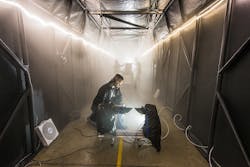Image: Sandia National Laboratories developed a fog chamber to test optics, like security camera sensors, in a controlled environment. Sandia chemical engineer Andres Sanchez checks an instrument that measures the particle size and concentration of the fog in the chamber’s atmosphere. (Image credit: Randy Montoya)
Recognizing that it is difficult to field test security cameras, sensors, or other optical equipment in fog that is often either too thick or too ephemeral, researchers at Sandia National Laboratories (Albuquerque, NM) have developed a controlled-fog environment for optical testing.
"Fog is difficult to work with because it rarely shows up when needed, it never seems to stay around long enough once you're ready to test and its density can vary during testing," said Sandia systems engineer Rich Contreras. And while the sunny, high desert of New Mexico may seem an unlikely place to make fog, Sandia has developed a fog chamber--one of the world's largest--that meets the needs of the military, other government agencies, and industry. The chamber is in a tunnel owned by the Air Force Research Laboratory.
RELATED ARTICLE: Boeing HEL MD high-energy laser targets UAVs/mortars even through wind and fog
Researchers say the chamber will help develop and validate cameras' and sensors' abilities to penetrate fog, knowledge that could lead to improved surveillance at sites. The chamber also could be used to answer fundamental optics questions, which in time could lead to improved security camera lenses and medical imaging equipment, safer aircraft landings and better vision for drivers in fog (see video below).
"People need to see through fog," said optical scientist Gabe Birch. "So much of the U.S. population is on the coastlines in places where fog exists. If you could discover an inexpensive technique to see better through it, there are a lot of people in industry who would be interested in that."
Sandia's fog chamber is 180 feet long, 10 feet tall and 11 feet wide. The chamber is enclosed by air curtains and rubber baffles to entrap the fog, approximating real-world conditions. Tunnel walls are painted with a special black paint to reduce reflection and improve data quality, Contreras said.
Sandia researchers use cloud microphysics to generate fog for video analytics, environmental testing, and new sensor development. Currently, the chamber's fog resembles that found in coastal regions, but output can be customized to produce fog physically similar to that found in any location, said Crystal Glen, an aerosol scientist. Researchers eventually hope to add smoke and dust to the chamber's repertoire.
The fog density can remain constant for up to 30 minutes, allowing a test to last 10-20 minutes. Adding a 30-second blast of fog particles can prolong the testing, Glen said, adding that the fog’s density can be controlled by the amount sprayed into the chamber or the particle size.
The layer of water around the fog seed particles either absorbs the photons or causes them to change direction in random ways, so that by the time they reach the cameras being tested, the wavelengths being picked up create a fuzzy image. Optics researchers refer to fog and seeing through bodily tissue in medical imaging as "scattering environments."
Different types of lighting representing specific sites could be installed in the chamber to see the combined effect of fog and lighting or the desired time of day, he said.
Examples of tests include showing raw data from various cameras, characterizing how different wavelengths and polarization states are influenced by fog, comparing different optical systems in a controlled foggy environment and resolution testing to see how the optical properties and resolution degrade in a variety of foggy environments. Recent research at Sandia has suggested that the polarization of photons could be exploited to see better through fog or other scattering environments.
Such testing could inform not only physical security camera design to better handle fog, but also medical imaging since the physics of these scattering events are the same.
SOURCE: Sandia National Laboratories; https://share.sandia.gov/news/resources/news_releases/fog_chamber/#.VYLhsEZd840
